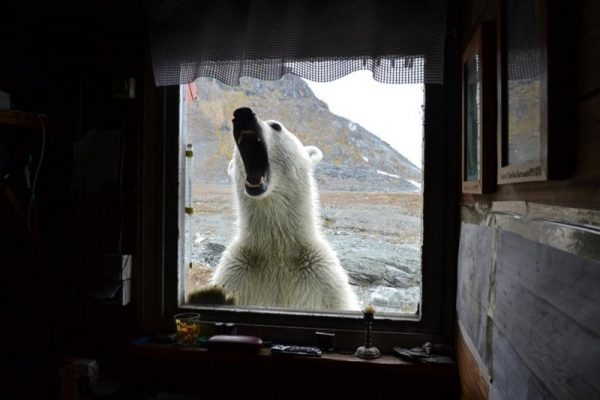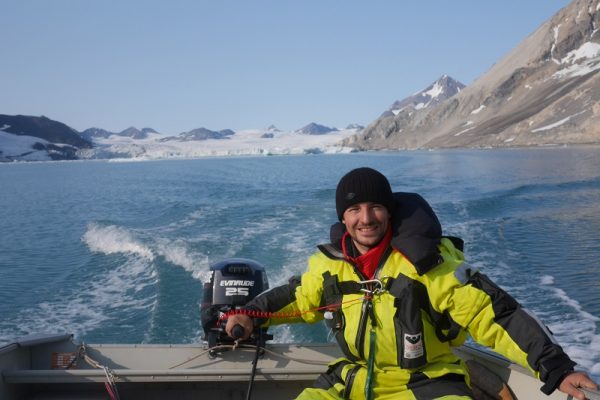Global warming leads to ice cover decline in the Arctic, which may soon result in the extinction of polar bear as a species. Polar Bear Day is celebrated on 27 February on the initiative of Polar Bears International. It is intended to increase the awareness of climate change risks in the society. Dr. Michał Ciepły and Dr. Marta Kondracka, who conduct research at Spitsbergen, tell us about the life of popular “white bears”.
 Dr. Michał Ciepły
Dr. Michał Ciepły
Czesław Centkiewicz wrote that Spitsbergen is the island of „fogs and windstorms”. Moving in the fog around Spitsbergen with the risk of meeting a polar bear can be an exciting adventure. When you arrive at Spitsbergen for the first time, having previously heard about dangerous encounters with bears, you get the feeling of the so-called “polar terror”. You walk around tense and look around nervously. However, as the days go by, and there is peace and calm around you, nobody meets a bear and your vigilance gradually declines, until you finally meet this large predator one day.
Polar bear (Ursus maritimus – sea bear), commonly known as the King of the Arctic”, is the largest terrestrial predator. The adult male usually weighs significantly more than half a ton. It is at the top of the food chain in the Arctic and has no respect for any other creatures around. This feature, combined with the inborn curiosity, means that people travelling behind the northern polar circle need to be on the alert. Every time a polar explorer walks out in the field, they must be aware of the danger and take care of their safety. We don’t go out alone, and always carry a gun, flare pistol and means of communication (radio and satellite phone). However, we must remember that it is us who are the guests in one of the last wild areas on our planet, so we must try not to disturb the “King of the Arctic” and give it a wide berth, just in case. An escape from this predator without mechanical vehicles is bound to fail. Polar bear is capable of gaining incredible speed at a short distance (even up to 40 km/h), while also being a great swimmer and diver. It is also a patient hunter that may be waiting several hours for a potential victim, for example while watching a breathing hole made by a seal in ice.
The Eskimos call polar bear “the great wanderer”, because it travels huge distance (up to 70 km per day). The bear is usually a loner. Only in the situations when a dead whale is washed out on shore, numerous groups of bears may prey next to one another for many days. Bears on Spitsbergen mainly wander in the winter, taking the “shortcuts” formed as a result of freezing of water areas. In the summer, a majority of them travel north, following the ice movement.
You can sometimes meet a mother with a young bear, and if it happens, you need to be especially careful because of the high curiosity of the bear cub and mother’s instinct that tells her to come to the rescue of the small bear immediately, even in the situation of the slightest risk.
An interesting fact is that the polar bear fur is not white. Its hair is transparent and filled with air, which provides the bear with good thermal insulation. Polar bears are not afraid of severe frosts. On the other hand, they risk death of overheating in the case of huge and long-term physical effort at a high air temperature.
The polar bear population has been significantly reduced as a result of intense hunting, mainly for their beautiful fur. An agreement to protect the “King of the Arctic” was concluded in 1973. However, the existence of polar bears is still very endangered, currently due to climate change and limited hunting grounds for these animals.

Dr. Joanna Szafraniec
The polar bear which came at the windows of Stanisław Baranowski Spitsbergen Polar Station would not be frightened off in any way. “Banging” pots with metal covers and spoons did not help, though these animals are usually scared of noise. This particular specimen must have been very hungry and was desperately looking for food.

Dr. Marta Kondracka (based on information from Polar Bears International)
Polar bear, the largest terrestrial predator in the world, is the youngest of eight bear species. Scientists believe that it evolved approximately 200,000 years ago from the brown bear ancestors. Its distribution range covers the whole Arctic. Scientists estimate that there are about 20-25 thousand polar bears. USA (Alaska), Canada, Russia, Denmark (Greenland) and Norway are five countries where polar bears have been found.
Male adults weigh between 351 and 544 kilograms and are 2–3.1 metre long. Females are much smaller – they usually weigh between 150 and 295 kilograms, and are 1.5–2.4 metre long. Polar bear paws are furry, which facilitates their movement on ice. The front paws have the diameter of up to 25 centimetres. Polar bears are perfectly adapted to survive in the Arctic. Two fur layers including thick undergrowth ended with protective hairs insulate them well against cold. The fat layer of polar bear, which is 7.6–11 centimetre thick, not only protects it against cold and increases its flotation in water, but it is also the key factor for survival during the periods of food deficiency. Small ears and short tail also protect bears from the loss of heat. During a storm polar bears curl up and cover their muzzles to keep themselves warm.
These animals have perfect smell, hearing and sight. Their sharpened senses are necessary to survive in the changing arctic conditions. They are also great swimmers – they can swim up to 100 kilometres without resting.
They feel best at home on the sea ice, where they prey on ringed and bearded seals which live under the ice. Bears are capable of sniffing a hole in ice used by seals for inhaling air at the distance of one kilometre and a half. They catch seals when they float into the holes.
Female bears usually have two cubs. Small polar bears are totally dependent on their mothers – to survive, they drink milk and eat prey that she hunted. They usually remain under her care for two years and a half. Their mother’s success in hunting for seals has a direct influence on the well-being of the whole family. Orphaned bear cubs are rarely able to survive in difficult arctic conditions. Bears learn to hunt through observation. They have to learn to wait patiently for seals at the ice holes. The polar bears which manage to survive and reach maturity (5–6 years old) have learnt to deal with the challenges of arctic life. In typical conditions, the mortality rate of adult polar bears is surprisingly low – only 5% per year. The main cause of bear death is hunger.
In freedom, adult polar bears live 15–18 years on the average, although biologists marked several 30-year old bears as well. Many bears in zoos live up to 35 years. Debby, which was the oldest polar bear in the world, lived 42 years at the Assiniboine Park zoo in Winnipeg. The biggest threat for polar bears is changes of their ice habitats due to global warming caused by the accumulation of greenhouse gases in the atmosphere.







